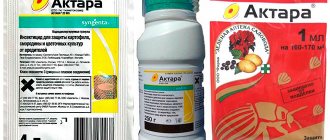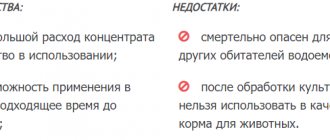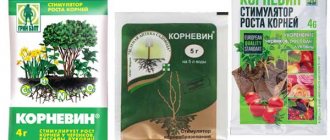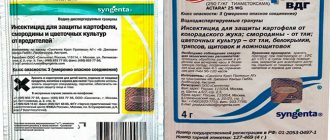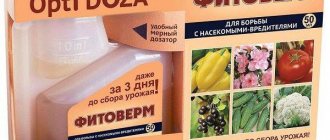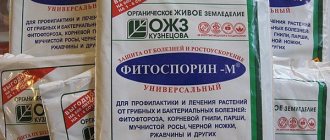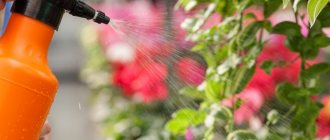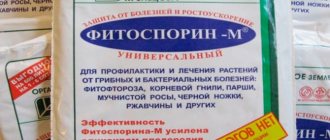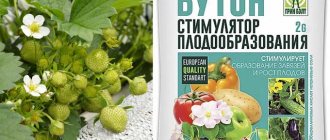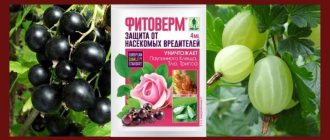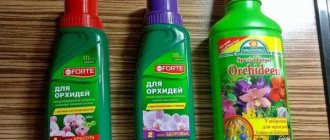Scope of application and release form of "Aktary"
The drug "Aktara" is produced in Switzerland. This insecticide began to be produced taking into account the wishes of customers. It can be used for the following purposes: to protect vegetables ; orchids, violets and roses in the garden; indoor plants.
Application is possible to get rid of a number of insects , all of which are not listed in the instructions. Thus, the instructions for Aktara (insecticide) do not mention that it copes with spider mites. But this does not mean that the drug is not able to get rid of it.
For ease of use, the drug "Aktara" has different release forms:
- liquid in the form of a suspension concentrate;
- granules soluble in water.
The drug in solid form is packaged in 4-gram sachets. According to the norm, this will be quite enough for spraying tomatoes in a greenhouse and other plants. But for use in large farms and agricultural enterprises, Aktara is used in large bags of 250 grams.
The suspension is in ampoules and vials . Small packaging helps to process the following types of plants:
- Small strawberry beds.
- Violet flower beds.
- Indoor flowers.
- Rose bushes.
- Orchids.
Aktara helps protect these and other plants from scale insects and spider mites.
Active ingredient and analogues
The insecticide contains thiamethoxam - this is its active ingredient, which makes up a quarter of the weight of the drug. “Aktara” is absorbed into the leaves of the plant through the skin or soil when watering. Then it spreads through the vessels.
When the drug permeates plant tissue, it is no longer afraid of rain or heat, because the insecticide works regardless of weather conditions.
Analogs of "Aktara" are:
How to use Aktar for orchids: instructions
Using the actara is quite simple, but first things first.
- How to dilute a granular preparation. It is most convenient to use small 1.4 g bags. For greater convenience, first prepare a stock solution. The required amount of aktar is poured into a container and filled with a small amount of water. After dissolution, the volume is brought to the calculated volume by adding water. Then everything is carefully and energetically shaken up and used on the spot. That's all the subtleties of how to dilute the drug.
- The drug in liquid form is diluted in the same way, in the same proportions and dosages as the granular version.
- The dosage for spraying is 4 g/10 l of water.
- The dosage for irrigation is 1.0-1.4 g/10 l of water.
Spraying must be carried out with a fine sprayer that produces a misty stream. Try to treat all vegetative parts of the plant: stem, pseudobulbs, peduncles, leaves on both sides, roots.
Since actara is a toxic substance, spraying should not be carried out in the living room or bedroom.
An open space, or at least a bathroom, is best suited for such procedures. The time of day does not play a significant role. Before processing, you must make sure that there are no strangers or pets nearby.
Important! Watering and treating orchids with actara using the immersion method is as important as spraying.
Repeated treatment should be carried out after 14-20 days, or after 6-8 days with another insecticide if the pest infestation has become widespread. However, usually the actor does an excellent job and there is no need to resort to such measures.
The use of strong chemicals, especially poisons, requires high dosage accuracy. However, the fact that the manufacturer recommends different doses of poison for different insects suggests that small overdoses are not critical for the plant.
You can safely poison parasites without fear of serious negative effects on the plant. It is possible to consider an overconsumption of a drug only when using it on an industrial scale, which loses all its relevance in a private greenhouse, house or apartment.
What pests does the drug protect against?
Insecticide "Aktara" helps save garden and vegetable plants from the following pests:
- Colorado beetle;
- Chafer;
- spider mite;
- whitefly;
- scale insect;
- Khrushchev larvae;
- aphid;
- thrips and others.
Splashes of the product when spraying plants fall on caterpillars and beetles, then penetrate their body and the poison begins to take effect. The insects eat the poisoned plants, ingesting an insecticide that destroys their nervous systems. After half an hour, the parasites cannot eat anything and soon die. If the insecticide is applied to the soil, underground pests are killed.
The drug "Aktara" costs 75-100 rubles for a package of 4 grams, and 3500-5 thousand rubles for 250 g, respectively. The product should be stored in utility rooms, on high shelves or closed cabinets. Children and animals should not get there.
It is not recommended to store food, medicine or feed near the drug. The room temperature should be between 10 degrees below zero and 35 degrees above zero. Do not store Aktara in places of high humidity.
Description of the drug Aktara
The chemical drug Aktara belongs to the category of new generation insecticides. Their distinctive feature is a sufficient degree of effectiveness against the main pests of indoor plants and a high speed of impact.
Properties and purpose
The chemical drug Aktara gained its popularity due to the following positive characteristics:
- the ability to quickly influence the pest (30-60 minutes after use);
- maintaining performance regardless of weather conditions;
- resistance to low and high humidity, sunlight;
- long-term exposure (1-2 months);
- good absorption by the underground and above-ground parts of the plant;
- no side effect of accumulation of toxic substances in green spaces;
- economical (with a small dosage it is possible to treat several pets);
- effective against most parasites;
- ease of breeding.
Application area
Spraying or watering flower crops with a working fluid based on Aktara is effective against the following parasitic individuals:
- Colorado potato beetle;
- codling moths;
- aphids;
- scale insects;
- soil fly;
- whiteflies;
- thrips;
- May beetle;
- spider mites, etc.
In order for an insecticidal drug to show its high effectiveness against harmful insects, it is necessary to become more familiar with the principle of its action and dosages.
"Aktara": instructions for use
You need to start working only when you first see ticks, beetles or caterpillars. Treatment should be carried out in calm, clear weather in the morning or evening, and only when you are sure that there will be no rain. An hour must pass after application for the insecticide to adhere to the leaves.
The prepared solution cannot be stored , so the composition should be prepared only in the quantity that you will need immediately. It is best to use a backpack sprayer, which is prepared directly in the can.
The preparation of Aktara looks like this:
- Dissolve four grams in a liter of water at a temperature of 25 degrees in the open air.
- Fill the sprayer tank a quarter full.
- Pour in the concentrate in the required volume for a particular plant.
- Fill the container with up to 5 liters of water.
- Close it tightly.
- Shake the sprayer.
Application for flowers and other plants
To protect your violets, cyclamen and other indoor plants from insects, you need to dilute 4 grams of the drug in 5 liters of liquid . This will be enough for a large greenhouse. For treating vegetable gardens, the consumption of the drug per 10 liters of liquid may vary slightly depending on the type of plant:
- Currants – 2 grams.
- Tomatoes - 4 g. by watering at the root.
- Cabbage seedlings against fleas - 3 g (at the root).
- Cucumbers - 3 grams when sprayed and 8 grams when applied to the soil.
- Onion – 4 g when sprayed.
- Eggplants – spraying – 3 grams and at the root 8 g.
- Roses, violets or orchids - 4 g for aphids and 16 for thrips.
- Fruit trees (plums, pears or apples) – 4 g.
- Grapes – 3 g.
Shrubs and fruit trees need to be treated for the first time before flowering and the beetle emerges , and for the second time after harvesting the fruits. Instructions for use contain information about the use of the drug depending on the pest and plant type.
If you use the drug in liquid form for different plants, you need to dilute one ampoule in the following amount of liquid:
- strawberries or currants – 6 liters
- orchids, roses and violets - 0.75 liters;
- onion – 3 liters.
Related article: Mospilan: instructions for use, reviews, storage of the drug
To prevent Aktara resistance from appearing in the cockchafer, whitefly or spider mite, its use must be alternated with other insecticides .
Planting processing
A preparation such as Aktara can also be used to treat planting material . A highly concentrated solution is required, the consumption is 4 grams per liter of water. To process potato tubers, 6 g of powder is dissolved in 0.3 liters of water.
And seeds, potato tubers, onion heads and garlic cloves need to be soaked in the composition . Do not be afraid of high concentrations of the product; it completely decomposes in 60 days.
After processing edible plants of any kind, they are safe for humans after a couple of months. Soaking in the composition plants take root and develop better If they get stronger, I will be less susceptible to harmful insects.
How to process?
Instructions for use Aktar:
- the chemical is suitable for use for 4 years after the date of issue;
- store in a dry place, preventing the drug from freezing;
- the pesticide is prepared in two stages: dilute the entire dose in a small amount of water, stir, and then add water to the required volume;
- when applying a chemical at the root, you first need to water the plant a little, and only then pour out the diluted preparation;
- Treatment for the purpose of treating vegetables and trees should begin as soon as the pest is noticed on them.
Use for preventive purposes is acceptable once a month.
For fruit trees and shrubs, spraying is recommended according to the following scheme:
- before flowering on a pink bud;
- after flowering with a massive emergence of codling moths, flower beetles, and moths;
- the third time - 21 days before harvest.
For vegetable seedlings:
- spray after transferring the bushes to the ground before flowering;
- the second time - three weeks before the start of harvest.
For decorative deciduous and flowering plants in the garden, Aktar can be used more often than once every 1-1.5 months:
- the pesticide can be used several times in a row without fear of weakening the effect of treatment;
- After preparation, use the working composition within 24 hours. There is no need to dilute a large package of chemical at once;
- the insecticide is toxic to bees, so it is not recommended to use it during mass flowering of fruit crops;
- to treat pests by applying poison to the root, the concentration of the substance per bucket of water is doubled. That is, if for spraying against scale insects you need to dilute 4 grams per bucket of water, then when watering use 8 grams.
How to process vegetables?
- Tomatoes, peppers, cucumbers, eggplants -
soak exposed roots by immersing the seedlings before planting in the ground. Dilute 1.4 g per 1 liter of water and immerse the seedlings in the prepared solution for 2 hours. - Potatoes, onions and garlic - soak tubers or heads for planting in beds. The dilution rate is 6 g per 300 ml of water. Place the planting material in a thin layer on the film and treat it with a chemical from a spray bottle. Plant immediately after finishing work, without waiting for the tubers to dry.
- Treatment of all vegetables during the growing season by leaf. The last spraying is allowed 21 days before harvest. Over the entire season, you can treat vegetables with this preparation 2–3 times. 1-1.4 g of the chemical should be diluted in 10 liters of water. Moisten the entire surface of the bush generously, not missing the underside of the leaves.
- Watering the preparation on the site to destroy wireworms and soil flies. The dilution rate for Aktara for irrigation is 2 g per 5 liters of water.
- Spraying potatoes during the growth period. A one-time treatment by spraying may be sufficient to prevent the Colorado potato beetle from appearing in the garden again this season. The dilution rate is 4 grams per bucket of water.
Aktara for fruit trees and shrubs
The advantage of Aktara over other insecticides in the treatment of fruit crops is that it penetrates into the leaves, but practically does not accumulate in the fruits. And also the poison quickly spreads throughout the adult tree within 15 - 20 hours. When watered at the root, after 1 - 2 days it already reaches the upper shoots.
How to dilute Aktara when spraying fruit trees? 1.4 g dissolves in 10 liters of water.
It works well against the following pests:
- codling moth;
- flower beetle;
- slowpoke;
- aphid.
It can be successfully used on apple and pear trees, stone fruits, and shrubs (currants, gooseberries, yoshta, and so on).
Aktara has proven itself well in the fight against phylloxera, which affects grapes. In this case, you need to combine root watering and spraying. The last application is recommended three weeks before harvest.
At the same time, this chemical does not work against grape itch (mites) and mites on strawberries.
Processing other horticultural crops
Ornamental crops in the garden are also attacked by pests. Roses and other flowers are often affected by aphids. Aktaru insecticide can be used once every 3 weeks to spray flowers against aphids. In this case, you need to dilute 14 g per 10 liters of water.
A serious problem for conifers is the attack of scale insects and false scale insects:
- These pests have a dense body shell and most poisons do not affect them.
- To combat such insects, systemic contact insecticides are used, which penetrate the cells of the tree and poison it.
- Scale insects, feeding on the sap of coniferous plants, die within two days.
- To achieve the maximum effect, combine wetting on the needles (dilute a package of Aktara 1.4 g per 8 l) and applying Aktara under the root (dilute a package of Aktara 4 g per 8 l).
Actara for indoor flowers
The insecticide is practically odorless and low-toxic. This allows you to use it at home. The dilution rate for Actara for processing per leaf is 1 g per 10 liters.
Tips for treating indoor plants:
- When watering at the root, the concentration of the chemical doubles.
- To treat flowers against mealybugs, scale insects and false scale insects, it is recommended to combine root watering and spraying.
- This pesticide is effective for all indoor flowers: roses, orchids, violets, cacti and all deciduous crops.
- Before starting work, it is better to take the plants outside or onto the balcony.
- It is better to remove insects from orchids by soaking the entire pot in a diluted preparation for several hours.
- There is often a need to re-apply after 7 – 10 days.
Safety rules for use
"Aktara" is a moderately dangerous drug for humans with toxicity class 3. It is used with gloves, a respirator and goggles . And also when working with chemicals, you need to wear a special uniform and wash it after each use.
At the end of the work, protective equipment and tools should be washed, and you should also wash your face, hands , swim, change clothes, and rinse your mouth. Only after all this should you eat or drink. Indoor plants are processed in the fresh air or in a well-ventilated room. Upon departure the symptoms are:
- Vomit.
- Nausea.
- General deterioration in health.
If you notice something like this in yourself, stop processing and go outside. If the insecticide gets on your skin, blot the drops with a cloth and wash it off with soapy water . If it gets into your eyes, wash them for 15 minutes under running water. And if swallowed, the stomach is washed and several tablets of activated carbon are taken.
After first aid has been provided to a person, he needs to call a doctor . To prevent anyone from swallowing the product, it should not be stored in food containers, and the containers should be labeled.
Do not pour the remaining solution near water bodies. And also do not process honey plants earlier than a week before flowering, so as not to kill the bees. Pastures should not be watered before grazing . After use, the tapa is burned in a place where no edible plants are planted.
"Aktara": reviews
Now let’s find out what those who have tried this product to protect their plants write in their reviews.
“Aktar” was recommended to me by experienced flower owners who have used it for their plants more than once. You need to spray them from all sides, and even the tray where the flowers stand. Remember that the drug is toxic, but the smell is not very strong. This makes it possible to use even at home.
It should be used once every six months. And if there is mealybug, then the plant needs to be treated 4 times within 4 days. Particular care must be taken to treat the center of the flower, where most of the larvae are concentrated.
I used Komandor and Molniya without success against Colorado beetles, after which I decided to try Aktara in granular form. Used to protect potatoes, flowers, and currants. The granules are highly soluble in water and should be used in the amount required depending on the type of plant.
I liked the drug, but the main drawback is that for one garden you need a lot of ampoules. I had previously used a lot of things for the Colorado potato beetle, but nothing helped. But I liked Aktara in liquid form. I poisoned the beetles in the morning, and in the evening they all died and did not appear for a month. Another big plus is the absence of an allergic reaction for sensitive skin.
As you can see, the drug "Aktara" helps protect indoor plants, as well as garden crops, from a number of pests. This even applies to spider mites, which are traditionally considered a fierce enemy of violets, orchids and roses and are not listed in the instructions for the product.
With this drug you can water the plants at the roots or spray them. Applying it at the root helps strengthen the planting and develop the root system of strawberries and vegetables. And this is not the only advantage of Aktara, which has a huge number of advantages compared to other drugs.
Security measures
Aktara belongs to low-toxic drugs of class 3 hazard for humans and mammals. To completely eliminate the risk of poisoning and burns, you must strictly adhere to the instructions and follow certain technology:
- when working with the substance, use gloves, a mask or a special respirator;
- manipulations with the insecticide are carried out in an open space; when working in a living room, a window is opened;
- refrain from drinking water, food and smoking at the time of contact with the drug;
- after use, burn the container of the used solution;
- After finishing all the work, wash your hands thoroughly and rinse your face.
Aktara - systemic insecticide
Systemic insecticide, also has an intestinal contact effect. Active ingredient: thiamethoxam, at a concentration of 250 g/kg and 240 g/l. Manufacturer: Syngenta Crop Protection AG, Switzerland. Available in the form of water-dispersible 1% granules, 25-35% suspension concentrate. Analogs and synonyms: Aktara, VDG; Aktara, KS; Doctor, TB; Adamant, gel; Cruiser, KS; Tiara, KS; Ephoria, KS, etc.
Used to protect garden crops and indoor plants from a wide range of pests (thrips, scale insects, scale insects, Colorado potato beetles, aphids, etc.), not effective against mites, ineffective against whiteflies!
Purpose of the drug
Aktara is intended for use as an insecticide from the neonicotinoid group. It is effective in getting rid of thrips, scale insects, whiteflies, scale insects, false scale insects, the Colorado potato beetle on potatoes, as well as aphids that live on berries and flower crops. The product has a low effectiveness against whiteflies, but has virtually no effect on arachnid pests.
Suitable for house plants. Does not affect resting puparia larvae, pupae, insect eggs, adults (non-feeding adults).
Instructions for use
Aktara belongs to the chemical class of neonicotinoids, acting on the nicotinic acetylcholine receptors of the insect nervous system. The active substance, thiamethoxam, penetrates mainly into the leaves through the vascular system, but practically does not enter the fruits. At the same time, the drug is completely redistributed throughout the leaf tissues of the plant 20 hours after watering. When watering large plants with actara, after 1 - 3 days the solution reaches the upper stems and shoots. Aktara is resistant to sunlight and does not reduce its effectiveness in dry air or rainy weather. The period of protective action is 14 - 28 days when sprayed on the leaf, 40 - 60 days when applied in soil.
There is a possibility of resistance arising (research has proven that pests become accustomed to repeated treatments), in particular, repeated outbreaks of damage by scale insects and whiteflies occur. This is also explained by the fact that actara acts on the larvae, i.e. Only at the feeding stage, if the root ball is not evenly moistened, the larvae hatched from the eggs can remain in the ground. And with each watering, the soil gets rid of traces of the insecticide. To prevent resistance, it is recommended to alternate actara with insecticides from other chemical groups. Aktara is compatible with most insecticides, fungicides, and growth regulators (Zircon, Epin, Amulet), except for drugs in which the solution has an alkaline reaction (Bordeaux mixture, soap, lime).
Article on the topic: Insecticide Karate Zeon: instructions for use of the drug, storage, compatibility
Treatment of indoor plants
An oversight during active growth means there is a high probability of missing pest damage. Fluke parasites will quickly lead to the degradation of indoor exotic plants. The sooner the entire window sill is treated with an available preparation, the greater the likelihood of plants recovering from pest damage.
One bag of dry matter is enough for 2-3 waterings, one is the main one, the other 2 are preventive to destroy the larvae hatched from the eggs.
Having measured out the required amount of Aktara, the substance is diluted in a separate container. A 2-liter plastic bottle is sufficient, but it is important to compare the volume of water with the recommended concentration. It is better to water indoor flowers at night - by the morning the first results of the treatment will be noticeable. If this is an indoor lemon, it is better to refuse to collect the first ripe fruits, planned in the coming days.
Amateur gardeners and workers in exotic plant nurseries prefer Aktara to many other drugs. It is needed in cases where simple spraying is not enough, for example, when affected by scale insects - the body of the fluke is securely covered with a wax shield, like that of a turtle. It is worth using this insecticide to ensure its effectiveness.
Consumption rates
Prepare a solution in warm water (the granules dissolve at a temperature not lower than 25°C), at the rate of 8 g of the drug per 10 liters of water - for watering the soil in pots (or soil in the garden) against aphids, whiteflies, thrips, scale insects and false scale insects, mealy mealybug and root mealybug. The consumption rate of working fluid is 10 liters per 10 m² (approximately 200-250 pots).
To use actara on indoor plants against most pests, simultaneous spraying and watering with actara solution are carried out. At the same time, for spraying, 1 sachet of actara, weighing 4 g, must be dissolved in 5 liters of water, this is enough to spray a whole greenhouse, so it is advisable to dilute 1 g per 1.25 liters of water. The easiest way is to pour the actara onto a white sheet of paper and divide it into four piles by eye - each will contain approximately 1 g. Pack the powder, 1 g, into separate bags and use as needed, dissolving in 1 liter of warm water.
If you use actara against weak pests: soil bugs (podura, collembola, enchytrea) or fungus gnats, it is enough to dilute 1 g of actara per 10 liters of water for irrigation.
How to breed aktar for garden plants and vegetables
- Tomatoes in open ground and greenhouses from aphids, whiteflies, Colorado beetles - for watering at the root 4 g of aktara per 10 liters of water, for spraying 1.2 g per 10 liters of water.
- Cucumbers against aphids, tobacco thrips, whiteflies - for watering at the root 8 g of aktara per 10 liters of water, for spraying 2-4 g per 10 liters of water.
- Eggplants and peppers from aphids, tobacco thrips, rose thrips - for watering at the root 4-8 g of aktara per 10 liters of water, for spraying 2-4 g per 10 liters of water.
- Onions for onion flies and thrips - for spraying 4 g per 10 liters of water.
- For apple trees, against the honeydew moth, you need to dilute 3 g of aktara per 10 liters of water for spraying. Pears - 4 g per 10 liters of water.
- Cabbage from flies and flea beetles, watering the seedlings with 3 g of actara per 10 liters of water.
- Spray roses against thrips with actara solution, norm: 16 g per 10 liters of water! For aphids, 4 g per 10 liters of water is enough.
- Grapes against leafhoppers and other pests: 3 g of aktar per 10 liters of water.
- Potatoes against the Colorado potato beetle: 1.2 g per 10 liters of water.
- Currants against aphids: 2 g of aktar per 10 liters of water.
For other garden plants, berry bushes and vegetables, the application rates for spraying and watering are the same: 4-8 g per 10 liters of water.
How to properly breed Aktara?
The insecticide can be used in several ways:
- pour under the roots of plants;
- spray on leaves;
- soak seedlings and tubers;
- moisten the planting holes.
For each type of crop, there are breeding standards for Aktara.
The product is effective against 100 types of pests.
Does not cause addiction to the active substance. Therefore, it is successfully used in the fight against most leaf-sucking and leaf-gnawing insects.
How to breed Aktara for spraying:
- aphids, whiteflies, Colorado beetles - 2 grams per 10 liters of water;
- roseate thrips – 4 grams per 10 liters of water;
- onion fly – 4 grams per 10 liters of water;
- moth moth – 3 grams per 10 liters of water;
- Scale insects and false scale insects - 4 grams per 10 liters;
- mining moths – 4 grams per 10 liters;
- cruciferous flea beetles - 3 grams per 10 liters;
- cutworms and whiteweed - 2 grams per 10 liters of water.
How to dilute Aktara for application at the root:
- wetting potato planting holes - 4 grams per 10 liters of water;
- watering strawberry bushes at the roots after harvesting - 4 grams per 10 liters of water;
- treatment for soil bugs (podura, collembola, enchytraea) - 1 gram per 10 liters of water;
- from cockchafer larvae - 4 grams per 10 liters of water;
- from wireworm - 4 grams per 10 liters of water.
Aktara liquid
Liquid Aktara for the Colorado potato beetle is available in 9 ml bottles or 1.2 ml ampoules. This is a suspension with a concentration of the active substance thiamethoxam of 240 g/l.
Despite the fact that the Colorado potato beetle is depicted on the packaging and is mentioned in the title, liquid actara destroys all pests except mites: aphids, thrips, whiteflies, scale insects, scale insects, false scale insects, podura, fungus gnats, codling moths, copperheads, etc. The consumption rates are as follows the same as actara in granules.
Since liquid actara is available in 1.2 ml packaging, it is easier to count using a syringe. For example, for currants, dilute the entire ampoule (1.2 ml) in 6 liters of water, for onion flies - 1.2 ml in 3 liters of water, and to cure roses from thrips with actara, you need to dilute 1.2 ml in 750 ml of water.
Purpose and application
The drug "Aktara" is used in private household plots and agriculture in both open and protected ground conditions. The use of the drug is part of a set of protective measures for treating greenhouses.
The action of the drug "Aktara" is aimed at protecting:
- potatoes - from soil pests and the Colorado potato beetle;
- tomatoes, cucumbers and other vegetable crops - from aphids, whiteflies, thrips;
- cabbage - from fleas and flies;
- peas - from pea moth, pea weevil, pea aphid;
- onions – from tobacco thrips and onion fly;
- flower crops and seedlings - from thrips, scale insects and false scale insects, soil flies and fungus gnats;
- grain crops - from the harmful bug, ground beetle;
- grapes, apple trees, pears - from copperheads, leafhoppers, flower beetles:
- and many more others.
When applied to the soil, Aktara has pronounced systemic activity, that is, it simultaneously protects against soil and ground pests.
Line of insecticides "Aktara, VDG" (water-dispersible granules)
Aktara reviews
In general, Aktara is very popular among flower growers, gardeners and gardeners. Almost alone, it holds the palm among insecticides. Firstly, the drug does not have a pungent odor, like all others. Secondly, because the drug is systemic - it spreads from the juices throughout the plant and destroys the pest if you simply water it, i.e. Spraying is not necessary, although it is advisable. The fact is that mealybugs, and these include mealybugs, rootbugs and scale insects, are very tenacious (they are protected by a shield or a wax coating). And when sprayed, actara cannot always penetrate deeply into the lower layers of the epidermis.
Therefore, one spraying is not enough against this group of pests, especially on plants with dense, leathery leaves or fruits. Here, only simultaneous spraying and watering with actara is effective. In this case, the treatment must be repeated after 10-12 days.
Attention: Rosselkhoznadzor warns about fake aktar.
Toxicity
Aktara has a hazard class - 2 or 3 (hazardous substance, the class depends on the concentration), hazard class 1 for bees (border protection zone for bees 4-5 km). Thiamethoxam is slightly toxic to birds, fish, earthworms and aquatic organisms. Not phytotoxic.
Waiting time - the time after treatment before harvesting is 14–21 days when spraying any crops and 40–60 days when watering the soil.
Security measures
Handle using gloves. While working, you must not smoke, drink, or eat. After work, wash your face and hands with soap and rinse your mouth. Store the drug in a cool, dry room at a temperature from -10C to +35C, separate from food and medicine, out of the reach of children and pets! Storage of the working solution is not allowed.
First aid for poisoning: if the drug gets on the skin, wash off with soap and water; In case of contact with eyes, rinse thoroughly with running water; if it enters the digestive tract, drink 3-4 glasses of water, induce vomiting, take several tablets of activated carbon, seek medical help. Symptoms of acute poisoning include ptosis of the eyelids, decreased motor activity, and tonic and clonic convulsions.
Safety rules before use
Any insecticide is used carefully. Aktara is a product that is assigned the third toxicity class. When processing orchid leaves and substrate with it, wear rubber gloves, safety glasses and a respirator. It is advisable to carry out the treatment not at home, but in special clothes, which are washed and ironed after the procedure. After using the drug, wash the instruments and tidy up your face and hands. Having done everything as written above, they sit down at the table, eat and drink.
Important! Experienced gardeners process the orchid in the fresh air or in a room that can be ventilated. Security measures are taken for a reason
Aktara causes poisoning if used carelessly, which manifests itself as follows: vomiting, nausea, deterioration of health. Having noticed symptoms, they stop treatment and go outside. Security measures are taken for a reason
Aktara causes poisoning if used carelessly, which manifests itself as follows: vomiting, nausea, deterioration of health. Having noticed symptoms, stop treatment and go outside.
Security measures are taken for a reason
Aktara causes poisoning if used carelessly, which manifests itself as follows: vomiting, nausea, deterioration of health. Having noticed symptoms, stop treatment and go outside.
If the drug gets on the skin, soak the area with a cloth or wash it under the tap with soap. In case of contact with eyes, rinsing for 15 minutes under running water will not hurt. To remove an insecticide that accidentally enters the stomach, take several tablets of activated carbon. It would be a good idea to see a doctor to avoid causing serious harm to your health.
What should flower growers remember?
- It is prohibited to store the insecticide in food containers.
- Do not dilute it in the container from which it is eaten.
- Do not pour the remaining solution near water bodies.
Aktara instructions for use, reviews, when to treat fruit trees/plants in the garden
Gardeners know that even if you take care of your garden perfectly, it is still impossible to protect it from pests. You shouldn’t wait for them to appear; it’s better to make sure they don’t happen. Protection against unwanted insects will help solve the problem. We will talk about one of the drugs in our article.
Article on the topic: Properties of potassium permanganate, use against diseases and as a fertilizer
Sometimes you can hear that Aktaru is called fertilizer. Perhaps this is because the substance can be applied to the soil, just like fertilizer. In fact, the drug has nothing to do with nutrients. It is designed to destroy harmful insects and arachnids. Learn more about what Aktara is, how it affects plants and how to use it in the garden in spring and autumn.
Use for various crops
After treating the bush with Aktara, all its parts are saturated with the substance for two to three hours; for a tree, this period is about two days, a maximum of three days. The preferred way of applying the substance is to water the plant with an aqueous solution at the root. Impregnation in this way causes Aktara to remain in its tissues for two months (60 days). In this case, such spraying should only be done by pouring the required amount of solution under the root of the plant.
Spraying is slightly less effective than other methods, but the duration of the effect is from two to four weeks, although the onset of impact is delayed for a certain period. It is for this reason that it is worth using the product exclusively when there is a mass attack of insects.
After proper processing, the bloodsuckers immediately throw away their stilettos, straighten their antennae and freeze. Despite the fact that the pulled out piercing organs make small cuts on the leaves, yield losses are insignificant or completely absent, since the damage heals very quickly without a trace or harm.
The product is not used for green plants (onions, cabbage, parsley and the like).
Houseplants
A 1.2 gram ampoule of the product is diluted in 6 liters of water (enough for 100-150 small plants); after treatment, the room is kept closed for 6 hours after spraying or 2 hours after watering.
Houseplants and the drug Aktara.
When processing in a room, a human operator should remain in a room with the door completely closed only after using personal protective equipment.
You can read in detail about using the product with indoor plants in our specialized material here.
Vegetables
For potatoes, the solution is prepared as follows: 4 grams are mixed with four buckets of water. This means that one sachet weighing 1.4 grams needs to be dissolved with one and a half buckets of liquid, and an ampoule of 1.2 grams is used for two buckets. For every hundred square meters of land, half a bucket of ready-made solution is required.
Emergency use against aphids, Colorado potato beetles and apple growers:
- cabbage (2 times every 14 days, 10 ml bag per 1 bucket per 2 acres);
- eggplants, tomatoes, peppers (same as cabbage, 1-2 sprays);
Spraying tomatoes.
Ground and greenhouse vegetables such as cucumbers and tomatoes are treated with a solution prepared as for potato tubers. The consumption should be about two buckets per one hundred square meters of garden, if the plants are up to one meter in length, 4 buckets per hundred square meters - if the height is more than one meter. Spot watering involves spending 50 ml. on under each bush.
Fruit trees and shrubs
Currants are treated with one ampoule of Aktara, dissolved in 6 liters of water. In this case, you need to pour 100 ml. for each bush, if it is 1 meter high, and 150 ml. for a one and a half meter currant bush.
Treatment of currant bush with Aktara.
The first time the treatment is carried out after harvesting, and the second time after the formation of foliage, but no later than one week before flowering.
You can learn more about the effects of the product on trees in this material.
What is the drug and how does it work
It is a means of protection against harmful insects, therefore it belongs to the category of insecticides. Used for the prevention and destruction of the following species:
- Colorado potato beetle,
- aphids,
- thrips,
- scale insects,
- worms.
"Aktara" is widely known as an effective remedy against the Colorado potato beetle, but it destroys many more pests.
Important! Note! The drug is ineffective against whiteflies. It does not work on ticks because they are arachnids and require acaricides against them.
The drug is produced by many manufacturers who assign their own name to the drug. The most common analogues are:
- Doctor, TB;
- Cruiser, KS;
- Ephoria, KS
- Tiara, KS, etc.
In order not to make a mistake in choosing a drug, you need to pay attention to the active substance - thiamethoxam, which paralyzes the nervous system of insects .
It is this that underlies all analogues.
Forms of production - in bags, as water-dispersible granules, or suspension in bottles or ampoules in the form of a liquid concentrate.
According to their mode of action, they belong to the category of systemic insecticides. This means that the substance penetrates into plant tissue and is redistributed along the stems and leaves through sap flow. Almost none gets into the fruits, which makes them safe for consumption.
If there is a need to use Aktara several times in a row, it is worth remembering that the drug has a fairly high resistance. This means that the group of insects against which the substance is used develop immunity and the drug no longer affects them. In this regard, it is better to change the drug during repeated treatments. Moreover, changing the name is not enough; it is important to make sure that the product contains a different active ingredient. During the third or fourth session, you can return to Aktar again.
Properties of the drug Aktara
Aktara helps:
- protect the plant from various pests,
- improve the quality of leaves and shoots.
Depending on the method of application, it is effective for 1-2 months after treatment.
Thiamethoxam, the active substance of the drug, decomposes well in the soil, dissolves in water and is absorbed by the plant from the ground. Thanks to these properties, the insecticide can be used for spraying vegetative parts and for soil treatment. The complex preparation can be used to completely control the reproduction process of various pests throughout the season.
Aktara is produced in ampoules, the use of which is more convenient than the other form - granules. However, both one and the other variety of the drug are popular among summer residents. The drug is effective against most pests of garden, vegetable and indoor crops. The instructions for use recommend using it to kill the following insects:
- mealybugs
- fungus gnats
- aphids
- Colorado potato beetle
- soil beetles and their larvae
- onion and carrot flies
- thrips
- scale insects
- codling moths, leafhoppers and copperheads and many others
The product effectively destroys plant-feeding stages of insects, since if pests enter the digestive tract, it penetrates better into the nervous tissues.
- Aktara has several advantages:
- The drug works equally well when applied to the leaves of the plant and watered with a solution at the root
- The active substance of Aktara penetrates the vascular system of the plant and is distributed only in the vegetative parts. Toxins are not detected in fruits, ovaries and inflorescences
- The active compound of the drug does not lose effectiveness under the influence of sunlight or high temperatures, as it penetrates into the intercellular space of plants. It is not afraid of precipitation; even during rains, the concentration of thiamethoxam remains at the original level
- The effect of Aktara lasts up to 4 weeks when applied to leaf blades, and up to 8 when applied to the soil, which allows you to protect plants for a long time and reduce the number of treatments per season
The declared advantages and properties of the drugs are valid if Aktara is used correctly. Before using it, it is recommended to carefully study the instructions.
It is a crystalline powder, light cream in color, and odorless. Aktara is often used in agriculture. The drug belongs to the group of chemical neonicotinoids. According to the method of use, it is an intestinal-type insecticide. It is used both for treating vegetation before the flowering period and for spraying seeds.
The drug is manufactured in Switzerland. It is noteworthy that its manufacturer took into account consumer preferences when developing it. It is for this reason that many gardeners use Aktara to protect violets, orchids, roses and vegetable crops on the site, as well as indoor plants.
The drug is produced in different forms:
- concentrated suspension;
- soluble granules.
The liquid is in bottles and ampoules. With their help, you can provide reliable protection for the following plants:
- violets;
- strawberry beds;
- indoor vegetation;
- orchids;
- rose bushes.
This insecticide is popular because:
- quickly penetrates into all parts of the plant;
- destroys larvae and adults;
- instantly dissolves in water and does not smell;
- the drug protects the plant from many pests at the same time for a long time;
- low solution consumption and small number of treatments;
- long residual effect;
- maintaining activity when humidity, temperature and dry air increase;
- resistant to sunlight.
The average price of the drug Aktara is 150 rubles.
Methods of application
"Aktara" can be applied in two ways - by watering into the soil and by foliar spraying.
- When applied to the soil , the drug rises through the root system along the stems and leaves. A day after watering, it spreads throughout the vascular system of grass crops. It will take three to four days to distribute into the tissues of large plants. For effective spraying, it is better to use sprayers that create a water mist.
- If the drug is used for spraying the ground part , fine sprayers are necessary for uniform application to the stems and leaves. During operation, you need to shake the container from time to time so that the suspension does not separate into sediment and liquid. Leaf processing is carried out in dry, windless weather. It is important that there is no rain for 5 – 7 hours after spraying. During this time, plant tissues absorb the drug.
When applying by root, it is important to remember that with each watering and rain, the concentration of the drug in the soil decreases, and, therefore, its validity period in rainy weather is shorter than in dry weather. On average, the manufacturer indicates the period of influence - 40 - 60 days for soil treatment and 15 - 20 days for foliar spraying.
Composition and principle of action
The active ingredient of the drug is thiamethoxam. In small doses, the synthetic compound causes stimulation of the nervous system of pests. Significant concentration leads to paralysis. Aktara belongs to the group of contact-intestinal insecticides. The substance is absorbed into the plant tissue, along with the cell sap enters the gastrointestinal tract of the insect and provokes its death. Pests with thin cover die after contact with the drug. Actara's effect does not apply to eggs, pupae and larvae.
The insecticide is used in 2 ways: spraying the ground parts of garden, vegetable and indoor crops and watering at the roots. In the first case, the solution is absorbed by the shoots in a matter of minutes. When applied to the soil, it takes several hours for the active substance to be distributed throughout all the vascular tissues of the plant. For fruit trees, this time is on average 1-3 days; for low-growing crops, 2-3 hours are enough.
Thiamethoxam mainly accumulates in plant leaves; its concentration in fruits is insignificant. The protective function of the drug lasts for 2-3 weeks after foliar treatment and 2.5-3 months after watering the soil.
How to prepare the product for use
The liquid suspension most often found on sale is in 9 ml bottles or 1.2 ml ampoules.
Before use, the contents of the package are diluted with water in the required concentration; it differs for different plants. If the ampoule is opened, its contents must be used at one time. The liquid from the bottle can be taken out in doses using a medical syringe. To ensure that the remaining drug does not lose its properties after opening, the hole is hermetically sealed with plasticine, baking dough or bread crumb.
Many insecticides, including Aktara, are mixed with products for other purposes and actions. This is convenient; with one treatment, the plant is fed and protected from diseases and pests. To do this, several drugs are used simultaneously. The main condition is their chemical compatibility. Most fungicides, acaricides, and growth regulators work well with this drug. It cannot be used with alkaline substances, for example, copper sulfate and other copper-containing compounds.
Tip #1 . "Aktara" is successfully used in tank mixtures together with fertilizers, fungicides and growth regulators. Sometimes the instructions contain a list of agents with which the drug can be successfully combined. It is clear that it is impossible to mention all the substances!
In order to accurately determine the compatibility of drugs that are planned to be introduced into the tank mixture, you must first dissolve a small amount of each in a separate container. Then, pour them one by one into a common container. If the solutions do not change color or precipitate, then they can be safely combined together in full.
Regardless of how Aktara is used separately or in mixtures, solutions of different saturations are prepared, each type of plant has its own dosage.
Advantages and disadvantages
a) Advantages of the drug "Aktara":
- A wide range of effects on a complex of common insects - plant pests (sucking and gnawing), including soil-dwelling and secretive ones.
- The effect of the drug does not depend on weather conditions, it retains its effect at high temperatures and low humidity, including rain resistance.
- The drug is non-selective and non-phytotoxic for plants in recommended applications.
- It is characterized by a high speed of initial impact and a long period of protective action.
b) The disadvantages include:
- The drug is resistant, therefore, to eliminate resistance to the insecticide, it is recommended to alternate with insecticides of other chemical classes.
- "Aktara" is ineffective against lepidopteran pests.
Specialist recommendation
Whatever form of release of Aktara is used, granular or in suspension, when preparing the solution for use, it is better to dilute the drug with warm water, not lower than +25 0.
After application, when the systemic drug is absorbed into the tissue, it is not afraid of heat up to +40 0, but during treatment and for 5-7 hours, the optimal temperature should be from +20 0 to +25 0, and the weather is without wind and rain .
S. V. Meshcheryakov Candidate of Biology. n. Leading agronomist of SpetsSelkhozProekt LLC.
Precautionary measures
Aktara is a substance of hazard class 3 (moderately dangerous substance), which dictates certain rules of behavior. Do not use food containers to prepare the drug.
During work, precautions must be taken and personal protective equipment must be used.
Smoking, drinking and eating is prohibited
If processing is carried out outdoors, you need to pay attention to the direction of the wind. After completing work, be sure to wash your hands and face with soap and rinse your mouth
Important! If the substance gets into your eyes or skin, rinse thoroughly with running water. In case of poisoning, consult a doctor
There is no specific antidote. Use symptomatic therapy.
Make it a habit to keep all chemicals out of the reach of children and animals, away from food and medications. Storage temperature 0-35 °C.
Shelf life: 4 years from the date of manufacture. Empty drug containers are burned after use. The prepared solution is used directly after preparation, on the spot.
Storage conditions and shelf life
Akara should be stored in a securely closed place at a temperature from – 10 0C to + 35 0C. Proximity to food products, animal feed, and other agrochemicals is prohibited. However, children and animals should not have access to this substance.
The effectiveness and safety of Aktara is guaranteed by the manufacturer only if the drug is used in strict accordance with the instructions for preparation, use, and disposal.
If the package has already been opened, dry Aktara will be good for another four years, and liquid Aktara for a maximum of one year. It is advisable to use any opened substance during the current season.
Working solutions prepared for use cannot be stored.
Functions and properties
The active ingredient of Aktara is thiamethoxam.
The chemical does not burn, but at high temperatures (from +140 ° C) melting begins. The components are highly soluble in water, especially at +25 °C, and do not leave sediment. The duration depends on the processing method. When sprayed, the effect lasts for 27 days, and when watering the soil - 2 months. Aktara disintegrates in the ground and leaves no traces after expiration.
Areas of use
The insecticide is designed to quickly kill insects and protect plantings from invasion. The product is actively used in agriculture and gardening, and it also helps home gardeners.
The drug "Aktara" is approved for:
- fruit trees;
- vegetable, grain crops;
- bushes;
- seedlings;
- exotic, garden plants.
The insecticide does not harm aquatic species, birds and earthworms, and has moderate toxicity to humans and mammals. Actara’s hazard class for pollinators is 1, therefore spraying during flowering is prohibited. Sanitary zone – within 5 km.
The product helps with:
- Colorado potato beetle;
- spider mite;
- thrips;
- whiteflies;
- codling moths;
- scale insects;
- soil flies;
- aphids.
Operating principle
The active substance quickly destroys hiding pests. When sprayed, the foliage absorbs the chemical, and after an hour it is already poisonous to insects. After watering, the components are absorbed by the roots and moved through the tissues. Toxicity appears after 1-2 days.
Parasites feed on treated parts of the crop. The chemical suppresses nutrient receptors and disrupts digestive functions. The pest stops eating, and the nervous system is paralyzed. The insect dies 24-30 hours after ingesting plant tissue.
To prevent addiction, it is necessary not to reduce the concentration of the solution.
Advantages and disadvantages
Aktara shows high efficiency in destroying more than 100 species of insects. The drug begins to work within 30 minutes and remains effective for 1 to 6 weeks.
The quality of etching is not affected by weather conditions, temperature and ultraviolet radiation. The product has an affordable price and is characterized by economical consumption.
The finished solution loses its properties after a day. The product is toxic to all pollinating species.
What is Aktara insecticide?
Aktara insecticide is widely used among gardeners and vegetable garden owners because it has the following important advantages:
- Used to protect plants from almost all known pests, including spider mites.
- The seedling is quickly absorbed into the soil, so it cannot be washed off with water, and after rain there is no need to repeat the treatment again.
- Economical consumption.
- Does not repel or poison predatory insects that prey on pests.
- Stimulates the growth of plant roots.
- Improves the quality of processed seeds and, as a result, the percentage of seed germination increases significantly.
- It is a potent agent, so it does not require a large number of sprays.
- Lasts for a long time.
- Combines well with other gardening products, such as organic and mineral fertilizers.
- Does not penetrate into fruits, so the harvest from treated plants will be safe and healthy.
Aktara insecticide
Important! The main active component of the Aktara insecticide, thiamethox, quickly decomposes in the soil, easily dissolves in water and is quickly absorbed into the tissues of the plant itself. This increases its effectiveness and helps to quickly and completely get rid of all types of pests. . The drug begins to act on average 25-30 minutes after spraying
It is quickly absorbed into the soil and tree tissue, which allows you to destroy insects not only outside, but also inside the plant. The main component, thiamethox, penetrates the digestive system of insects and has a paralytic effect on it. As a result, they can no longer eat or drink and soon die
The drug begins to act on average 25-30 minutes after spraying. It is quickly absorbed into the soil and tree tissue, which allows you to destroy insects not only outside, but also inside the plant. The main component, thiamethox, penetrates the digestive system of insects and has a paralytic effect on it. As a result, they can no longer eat or drink and soon die.
Spraying fruit trees
The product does not cause addiction among pests, so it can be used several times in a row without compromising quality. The validity period of the product depends on the processing method used. After spraying, protection against insects lasts for three weeks, but when watering the plant it will work for up to 60 days.
Aktara is available in two versions:
- Liquid concentrated suspension.
- Granules that must first be dissolved in water.
Small packages of 4 grams are created for the convenience of processing plants at home and in gardens.
Possible harm to plants and humans and how to minimize it
If you follow the instructions for use of the drug and do not exceed the permissible concentration of Aktara, then it will not cause any harm to indoor plants, even delicate and capricious orchids. If Aktara is applied too much, sensitization of the plant (hypersensitivity) is possible. In this case, the application dose must be reduced.
Important!
Some pubescent flowers (such as violets) may be damaged by spraying, so gentle watering must be used. Frequent watering may disrupt the permissible soil moisture level. This should be taken into account so that due to excess moisture, the sensitive roots of plants do not begin to rot.
Aktara is moderately toxic for people and animals and belongs to III (medium or moderate) hazard class. However, when handling it you still need to:
- use a respirator or gauze bandage, rubber or silicone gloves, safety glasses, a hat, overalls and appropriate footwear;
- When using a systemic insecticide, refrain from smoking, eating and drinking;
- thoroughly ventilate the room at all stages of work;
- work no more than 2 hours;
- refuse to use utensils that have been in contact with the substance for food purposes;
- store the drug at a permissible temperature range from +10 to +35 C, out of the reach of children and animals.
After all procedures, wash your face and hands with soap, rinse your mouth, and change into clean clothes.
The following symptoms indicate insecticide poisoning:
- decreased motor functions;
- convulsions;
- nausea;
- vomit;
- general weakness.
You may be interested in:
Scale insects on houseplants - how to fight at home An inconspicuous insect in the form of a motionless plaque on a house pet at first seems harmless, but in fact...Read more...
If such signs appear, the victim should immediately stop working. He needs to be taken to fresh air, given a glass of water with activated charcoal to drink, and then an additional 3 glasses of water and vomited (only if the person is conscious). After providing the necessary first aid, you should immediately contact a medical facility.
Preparation of Aktara working solution
The working solution of Aktara insecticide is prepared as follows: the contents of one ampoule are dissolved in a small amount of water and mixed well.
Then water is added to this working fluid to the required concentration. On a note!
Spraying of plants is carried out in the evening hours, when there is no wind or rain. The air temperature should be about 13-22 degrees Celsius. Typically, mass death of insects occurs after about 5-6 hours.
Popular drugs
Aktara
"Aktara" is a frequently used and popular insecticide among gardeners, used in
Acts through direct contact or the digestive system. Differs in speed of influence. Aphids are affected on average within 15 minutes. Other insects stop feeding an hour after spraying. Complete destruction of pests occurs within one day.
Resistant to high temperatures and rain. Equally effective when applied to the soil, processing seed and spraying bushes. Does not cause addiction to neonicotinoids.
The protection lasts for two months. Preventative treatment before pests appear is possible.
It has reduced toxicity to earthworms, birds, and fish.
The drug is used to treat potatoes, cucumbers, tomatoes, flowers in flowerbeds and pots.
The insecticide is dangerous for bees. Spraying near apiaries is prohibited.
Cruiser
"Cruiser" is used for seed treatment. The concentrate solution is moistened
Protection after treatment is effective for six to eight weeks. The treated seed can be stored for a year - the effectiveness does not decrease and no adverse effects from the drug are observed.
The insecticide is considered as safe as possible for humans.
The drug is economical in consumption. One ton of planting materials requires from 0.3 to 1.5 liters of insecticide.
It destroys wireworms, Swedish flies, darkling beetles, aphids, flea beetles, Colorado potato beetles, and leaf flea beetles.
Voliam Flexi
Relatively safe for humans. Does not irritate eyes and skin, has no odor. Resistant to precipitation and retains protective properties for thirty days. Two treatments can be done per season.
Within an hour after treatment, the pests stop feeding. They die on the third or fourth day.
To avoid addiction in insects, you cannot treat with the drug twice in a row on the same field.
The concentrate is used to treat vineyards, tomato and cabbage seedlings, and potatoes. Contributes to the destruction of cutworms, ground beetles, bedbugs, flea beetles, thrips, and Colorado potato beetles.
Celeste Top
"Celest Top" is used for processing potato tubers and grain seeds.
Protects plants not only from insect pests, but also from fungal diseases. It has a prolonged validity period (up to ninety days).
The concentrate is recommended for processing early varieties of potatoes. Does not accumulate in tubers and does not require a waiting period after treatment.
Does not lose effectiveness during dry periods. Effective at elevated summer temperatures.
Stimulates the growth and development of plants. Destroys fungal pathogens of scab, dry rot, fomoz.
It is used to destroy the Colorado potato beetle, aphids, thrips, beetles and wireworms. One treatment per season is enough.
Ephoria
"Ephoria" is used to combat leaf-eating and sucking insects that lead a hidden lifestyle.
The insecticide has a pronounced systemic effect. When processing, it is not necessary to spray the entire plant - it is enough to apply the preparation to the growing point and the upper tiers of the stems.
The effectiveness of the active substance is not lost in hot and dry weather.
One treatment (less often two) is required per season.
It is used for spraying wheat, oats, barley, cabbage and pea plantations. Destroys cutworms, pea weevils, aphids, codling moths, leeches, thrips, turtle bugs, bread beetles and flea beetles.
Adamant
Available in the form of a gel, which is used to treat baseboards, cracks in the floor and wall, as well as cockroach habitats.
One package of insecticide (20 grams) is designed to treat a room of 25 square meters.
Insects die en masse within three days. Protection lasts up to two and a half months. The active ingredients are not dangerous to humans. The gel is allowed to be used in children's institutions and public canteens.
It is intended primarily for the destruction of ants and cockroaches.
Compatibility with other drugs
This drug is compatible with many other popular insecticides and fungicides in gardening and agriculture, as well as growth regulators (Ribav-Extra, Zircon, Epin, etc.). Aktar should not be combined with drugs that give an alkaline reaction. In any case, before mixing any products, you should first check their compatibility.
The drug "Aktara" is indispensable because of its effectiveness against many types of insect pests. However, the drug also has analogues, which are the following products: “Adamant”, “Cruiser”, “Tiara”, “Doctor”, “Voliam Flexi” and “Ephoria”. These insecticides have similar properties and functions. These drugs, like Aktara, contain thiamethoxam, their main active ingredient.
